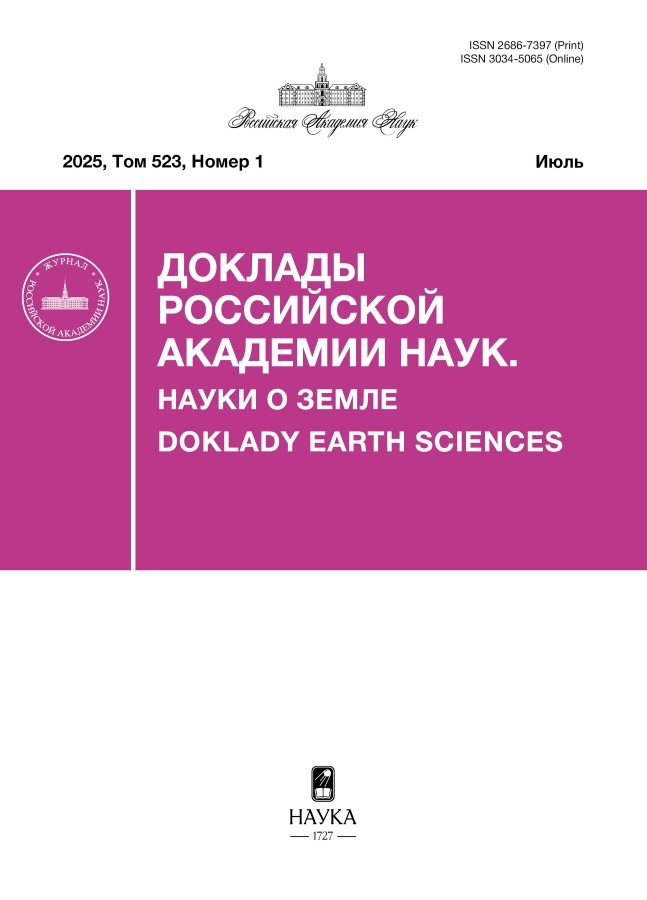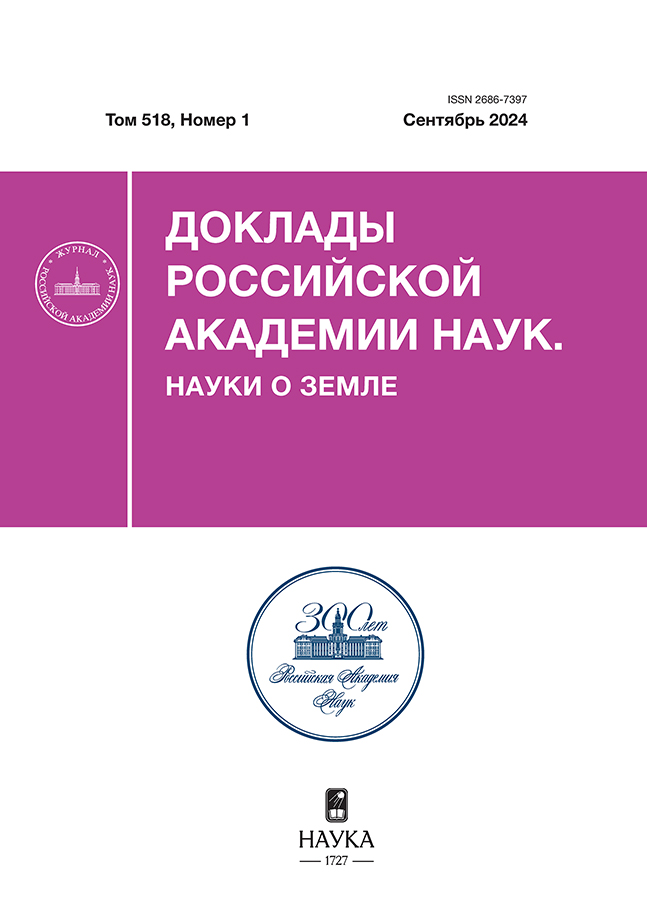Базальты рифейских толщ Башкирского мегантиклинория (Южный Урал): новые 147Sm‒143Nd- и Rb‒Sr ID-TIMS-изотопные-ограничения
- Авторы: Пучков В.Н.1, Ронкин Ю.Л.1, Сергеева Н.Д.2
-
Учреждения:
- Институт геологии и геохимии Уральского отделения Российской Академии наук
- Институт геологии Уфимского федерального исследовательского центра Российской Академии наук
- Выпуск: Том 518, № 1 (2024)
- Страницы: 85-96
- Раздел: ПЕТРОЛОГИЯ
- Статья получена: 31.01.2025
- Статья опубликована: 29.11.2024
- URL: https://ruspoj.com/2686-7397/article/view/649927
- DOI: https://doi.org/10.31857/S2686739724090098
- ID: 649927
Цитировать
Полный текст
Аннотация
Представлены первые результаты 147Sm‒143Nd- и Rb–Sr ID-TIMS-изотопно-геохронологического сравнительного изучения двенадцати образцов вулканитов Башкирского мегантиклинория, для которых ранее по цирконам, выделенным из этих образцов, было осуществлено U–Pb SHRIMP-II-датирование, выявившее доминирование палеозойских возрастов среди трёх событийно-стратиграфических уровней в рифее Южного Урала. Новые 147Sm‒143Nd- и Rb–Sr ID-TIMS-изотопные данные показали, что эволюция вулканитов происходила, в результате корово-мантийного взаимодействия. В Тараташском антиклинории Nd-модельные возрасты (TDM) 2302–2540 млн лет) вулканитов расцениваются как возрасты протолита, характеризующегося величинами εNd(t): от –17.4 до –20.5. В Ямантауском антиклинории значение TDM (2033 млн лет) палеозойских вулканитов свидетельствует о более молодом (палеопротерозойском) субстрате. Минимальные Nd-модельные возрасты (TDM = 1160–1233 млн лет) определены для палеозойских вулканитов, пространственно связанных с метабазальтами игонинского магматического события (707–732 млн лет) в Тирлянской синклинали. Наименьшие значения εNd(t) (–3.2, –0.9, –0,7), свидетельствующие о снижении доли корового компонента по отношению к мантийному веществу, получены в метабазальтах палеозоя в Тирлянской синклинали на восточном крыле Башкирского мегантиклинория, что, возможно, связано с активизацией плюмовых процессов на востоке горно-складчатого сооружения. Таким образом, Rb–Sr- и 147Sm‒143Nd ID-TIMS-изотопные систематики изученных вулканитов дают возможность расширить понимание мантийно-коровых явлений в пределах трёх событийно-стратиграфических уровней рифея Южного Урала.
Об авторах
В. Н. Пучков
Институт геологии и геохимии Уральского отделения Российской Академии наук
Email: y-ronkin@mail.ru
Член-корреспондент РАН
Россия, ЕкатеринбургЮ. Л. Ронкин
Институт геологии и геохимии Уральского отделения Российской Академии наук
Автор, ответственный за переписку.
Email: y-ronkin@mail.ru
Россия, Екатеринбург
Н. Д. Сергеева
Институт геологии Уфимского федерального исследовательского центра Российской Академии наук
Email: y-ronkin@mail.ru
Россия, Уфа
Список литературы
- Пучков В. Н., Козлов В. И., Краснобаев А. А. Палеозойские U-Pb SHRIMP-датировки магматических пород Башкирского мегантиклинория // Геологический вестник. 2011. № 9. Юбилейный выпуск. Институт геологии УНЦ РАН. Уфа: ДизайнПолиграфСервис. С. 36–43.
- Краснобаев А. А., Пучков В. Н., Сергеева Н. Д., Бушарина С. В. Полихронные цирконы вулканитов Навышского комплекса айской свиты нижнего рифея (Южный Урал) // Георесурсы. 2020. Т. 22. № 4. С. 101–112 https://doi.org/10.18599/grs.2020.4.101-112
- Краснобаев А. А., Пучков В. Н., Сергеева Н. Д., Бушарина С. В. Природа цирконовой кластики в песчаниках рифея и венда Южного Урала // Георесурсы. 2019. Т. 21. № 1. С. 15–25. https://doi.org/10.18599/grs.2019.1.15-25
- Ludwig K. R. User's manual for Isoplot 3.6: a geochronological toolkit for Microsoft. Excel. 2008. № 4. 77 p.
- Puchkov V. N., Krasnobaev A. A., Sergeeva N. D. The New Data on Stratigraphy of the Riphean Stratotype in the Southern Urals, Russia // Journal of Geoscience and Environment Protection. 2014. № 2. P. 108–116
- Стратиграфический кодекс России. СПб.: Издательство ВСЕГЕИ, 2019. 96 с. (МСК России, ВСЕГЕИ)
- Ronkin Y. L., Karaseva T. V., Maslov A. V. The First 147Sm–143Nd Data on Rocks from the 6925.2- to 8250-m Interval of the SG-7 Superdeep Borehole (West Siberian Oil-and-Gas Province) // Dokl. Earth Sc. 2021. 496. 130–134. https://doi.org/10.1134/S1028334X2102015X
- Петрографический кодекс России. Магматические, метаморфические, метасоматические, импактные образования. Изд. 2. СПб.: Изд-во ВСЕГЕИ, 2008. 200 с.
- DePaolo D. J. Neodymium Isotope Geochemistry. An Introduction. Minerals and Rocks Series. 1988. № 20. xi + 187 pp.
- Ронкин Ю. Л., Хойман К. Определение погрешностей Sm-Nd модельных датировок // Труды Института геологии и геохимии им. акад. А.Н. Заварицкого. 2009. Выпуск 156 (Ежегодник 2008). Екатеринбург. С. 334–336.
- Papanastassiou D. A., Wasserburg G. J. Initial strontium isotopic abundances and the resolution of small time differences in the formation of planetary objects // Earth Planet. Sci. Let. 1969. 5: 361–376.
- Краснобаев А. А., Бибикова Е. В., Ронкин Ю. Л., Козлов В. И. Геохронология вулканитов айской свиты и изотопный возраст нижней границы рифея // Известия АН СССР, серия геологическая. 1992. № 6. С. 25–40.
- Магматические горные породы (кислые и средние породы). Отв. ред. В.В. Ярмолюк, В.И. Коваленко. М.: Наука, 373 с.
- Краснобаев А. А., Бибикова Е. В., Степанов А. И., Кирнозова Т. И., Ронкин Ю. Л., Макаров В. А., Лепихина О. П., Кравцов А. В. Возраст эффузивов машакской свиты и проблема изотопно-геохронологической границы нижний-средний рифей / В книге: Изотопное датирование процессов вулканизма и осадкообразования. М.: “Наука”, 1985. С. 162–175.
- Arndt N. T., Goldstein S. L. Use and abuse of crust-formation ages // Geology. 1987. 15. P. 893–895.
- Puchkov V. N., Ernst R. E., Ivanov K. S. The importance and difficulties of identifying mantle plumes in orogenic belts: An example based on the fragmented large igneous province (LIP) record in the Ural fold belt // Precambrian Research. 2021. 361. 106–186. https://doi.org/10.1016/j.precamres.2021.106186
- Ronkin Yu. L., Sindern S., Maslov A. V., Matukov D. I., Kramm U., Lepikhina O. P. Oldest (3.5 Ga) zircons of the Urals: U-Pb (SHRIMP-II) and T DM constraints // Doklady Earth Sciences. 2007. 415(6). 860‒865 https://doi.org/10.1134/S1028334X07060074
- Ронкин Ю. Л., Синдерн С., Лепихина О. П. Изотопная геология древнейших образований Южного Урала // Литосфера. 2012. № 5. С. 50–76.
- Dickin A. P. Model Ages (Sm-Nd). Encyclopedia of Scientific Dating Methods. 2014. 1–7. https://doi.org/10.1007/978-94-007-6326-5_2-2
- McNutt R. H., Dickin A. P. A comparison of Nd model ages and U-Pb zircon ages of Grenville granitoids: constraints on the evolution of the Laurentian margin from 1.5 to 1.0 Ga // Terra Nova. 2012. 24. 7–15.
Дополнительные файлы











